Research on Binance Futures Multi-currency Hedging Strategy Part 2
 0
0
 1543
1543

The original research report address: https://www.fmz.com/digest-topic/5584 You can read it first, this article won’t have duplicate content. This article will highlights the optimization process of the second strategy. After the optimization, the second strategy is improved obviously, it is recommended to upgrade the strategy according to this article. The backtest engine added the statistics of handling fee.
# Libraries to import
import pandas as pd
import requests
import matplotlib.pyplot as plt
import seaborn as sns
import numpy as np
%matplotlib inline
symbols = ['ETH', 'BCH', 'XRP', 'EOS', 'LTC', 'TRX', 'ETC', 'LINK', 'XLM', 'ADA', 'XMR', 'DASH', 'ZEC', 'XTZ', 'BNB', 'ATOM', 'ONT', 'IOTA', 'BAT', 'VET', 'NEO', 'QTUM', 'IOST']
price_usdt = pd.read_csv('https://www.fmz.com/upload/asset/20227de6c1d10cb9dd1.csv ', index_col = 0)
price_usdt.index = pd.to_datetime(price_usdt.index)
price_usdt_norm = price_usdt/price_usdt.fillna(method='bfill').iloc[0,]
price_usdt_btc = price_usdt.divide(price_usdt['BTC'],axis=0)
price_usdt_btc_norm = price_usdt_btc/price_usdt_btc.fillna(method='bfill').iloc[0,]
class Exchange:
def __init__(self, trade_symbols, leverage=20, commission=0.00005, initial_balance=10000, log=False):
self.initial_balance = initial_balance # Initial asset
self.commission = commission
self.leverage = leverage
self.trade_symbols = trade_symbols
self.date = ''
self.log = log
self.df = pd.DataFrame(columns=['margin','total','leverage','realised_profit','unrealised_profit'])
self.account = {'USDT':{'realised_profit':0, 'margin':0, 'unrealised_profit':0, 'total':initial_balance, 'leverage':0, 'fee':0}}
for symbol in trade_symbols:
self.account[symbol] = {'amount':0, 'hold_price':0, 'value':0, 'price':0, 'realised_profit':0, 'margin':0, 'unrealised_profit':0,'fee':0}
def Trade(self, symbol, direction, price, amount, msg=''):
if self.date and self.log:
print('%-20s%-5s%-5s%-10.8s%-8.6s %s'%(str(self.date), symbol, 'buy' if direction == 1 else 'sell', price, amount, msg))
cover_amount = 0 if direction*self.account[symbol]['amount'] >=0 else min(abs(self.account[symbol]['amount']), amount)
open_amount = amount - cover_amount
self.account['USDT']['realised_profit'] -= price*amount*self.commission # Minus handling fee
self.account['USDT']['fee'] += price*amount*self.commission
self.account[symbol]['fee'] += price*amount*self.commission
if cover_amount > 0: # close position first
self.account['USDT']['realised_profit'] += -direction*(price - self.account[symbol]['hold_price'])*cover_amount # Profit
self.account['USDT']['margin'] -= cover_amount*self.account[symbol]['hold_price']/self.leverage # Free margin
self.account[symbol]['realised_profit'] += -direction*(price - self.account[symbol]['hold_price'])*cover_amount
self.account[symbol]['amount'] -= -direction*cover_amount
self.account[symbol]['margin'] -= cover_amount*self.account[symbol]['hold_price']/self.leverage
self.account[symbol]['hold_price'] = 0 if self.account[symbol]['amount'] == 0 else self.account[symbol]['hold_price']
if open_amount > 0:
total_cost = self.account[symbol]['hold_price']*direction*self.account[symbol]['amount'] + price*open_amount
total_amount = direction*self.account[symbol]['amount']+open_amount
self.account['USDT']['margin'] += open_amount*price/self.leverage
self.account[symbol]['hold_price'] = total_cost/total_amount
self.account[symbol]['amount'] += direction*open_amount
self.account[symbol]['margin'] += open_amount*price/self.leverage
self.account[symbol]['unrealised_profit'] = (price - self.account[symbol]['hold_price'])*self.account[symbol]['amount']
self.account[symbol]['price'] = price
self.account[symbol]['value'] = abs(self.account[symbol]['amount'])*price
return True
def Buy(self, symbol, price, amount, msg=''):
self.Trade(symbol, 1, price, amount, msg)
def Sell(self, symbol, price, amount, msg=''):
self.Trade(symbol, -1, price, amount, msg)
def Update(self, date, close_price): # Update assets
self.date = date
self.close = close_price
self.account['USDT']['unrealised_profit'] = 0
for symbol in self.trade_symbols:
if np.isnan(close_price[symbol]):
continue
self.account[symbol]['unrealised_profit'] = (close_price[symbol] - self.account[symbol]['hold_price'])*self.account[symbol]['amount']
self.account[symbol]['price'] = close_price[symbol]
self.account[symbol]['value'] = abs(self.account[symbol]['amount'])*close_price[symbol]
self.account['USDT']['unrealised_profit'] += self.account[symbol]['unrealised_profit']
if self.date.hour in [0,8,16]:
pass
self.account['USDT']['realised_profit'] += -self.account[symbol]['amount']*close_price[symbol]*0.01/100
self.account['USDT']['total'] = round(self.account['USDT']['realised_profit'] + self.initial_balance + self.account['USDT']['unrealised_profit'],6)
self.account['USDT']['leverage'] = round(self.account['USDT']['margin']/self.account['USDT']['total'],4)*self.leverage
self.df.loc[self.date] = [self.account['USDT']['margin'],self.account['USDT']['total'],self.account['USDT']['leverage'],self.account['USDT']['realised_profit'],self.account['USDT']['unrealised_profit']]
The performance of the original strategy, after the currency type selection, performed well, but there are still many holding positions, generally around 4 times
Principle:
- Update the market quotes and account holding positions, the initial price will be recorded in the first run (newly added currencies are calculated according to the time of joining)
- Update the index, the index is the altcoin-bitcoin price index = mean (sum ((altcoin price / bitcoin price) / (altcoin initial price / bitcoin initial price)))
- Judging long and short operation according to the deviation index, and judging the position size according to the deviation size
- Placing orders, the order quantity is determined by the iceberg commission strategy, and the transaction is executed according newest executable price
- Loop again
trade_symbols = list(set(symbols)-set(['LINK','XTZ','BCH', 'ETH'])) # Remaining currencies
price_usdt_btc_norm_mean = price_usdt_btc_norm[trade_symbols].mean(axis=1)
e = Exchange(trade_symbols,initial_balance=10000,commission=0.0005,log=False)
trade_value = 300
for row in price_usdt.iloc[:].iterrows():
e.Update(row[0], row[1])
empty_value = 0
for symbol in trade_symbols:
price = row[1][symbol]
if np.isnan(price):
continue
diff = price_usdt_btc_norm.loc[row[0],symbol] - price_usdt_btc_norm_mean[row[0]]
aim_value = -trade_value*round(diff/0.01,1)
now_value = e.account[symbol]['value']*np.sign(e.account[symbol]['amount'])
empty_value += now_value
if aim_value - now_value > 20:
e.Buy(symbol, price, round((aim_value - now_value)/price, 6),round(e.account[symbol]['realised_profit']+e.account[symbol]['unrealised_profit'],2))
if aim_value - now_value < -20:
e.Sell(symbol, price, -round((aim_value - now_value)/price, 6),round(e.account[symbol]['realised_profit']+e.account[symbol]['unrealised_profit'],2))
stragey_2b = e
(stragey_2b.df['total']/stragey_2b.initial_balance).plot(figsize=(17,6),grid = True);
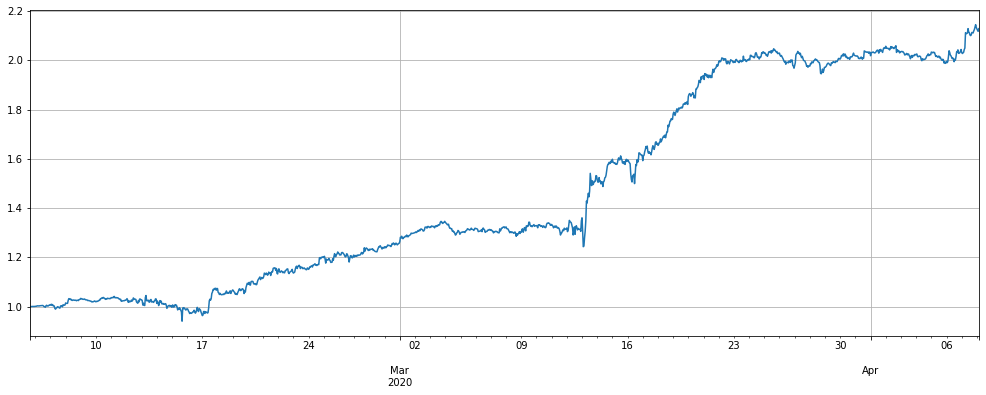
stragey_2b.df['leverage'].plot(figsize=(18,6),grid = True); # leverage
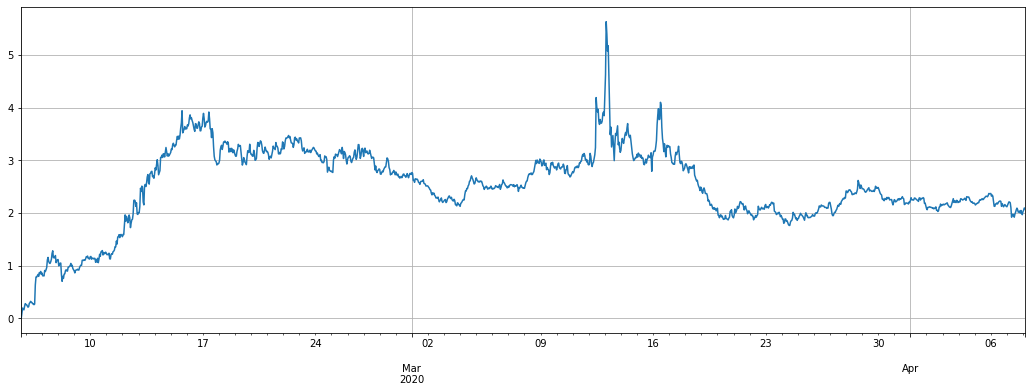
pd.DataFrame(e.account).T.apply(lambda x:round(x,3)) # holding position
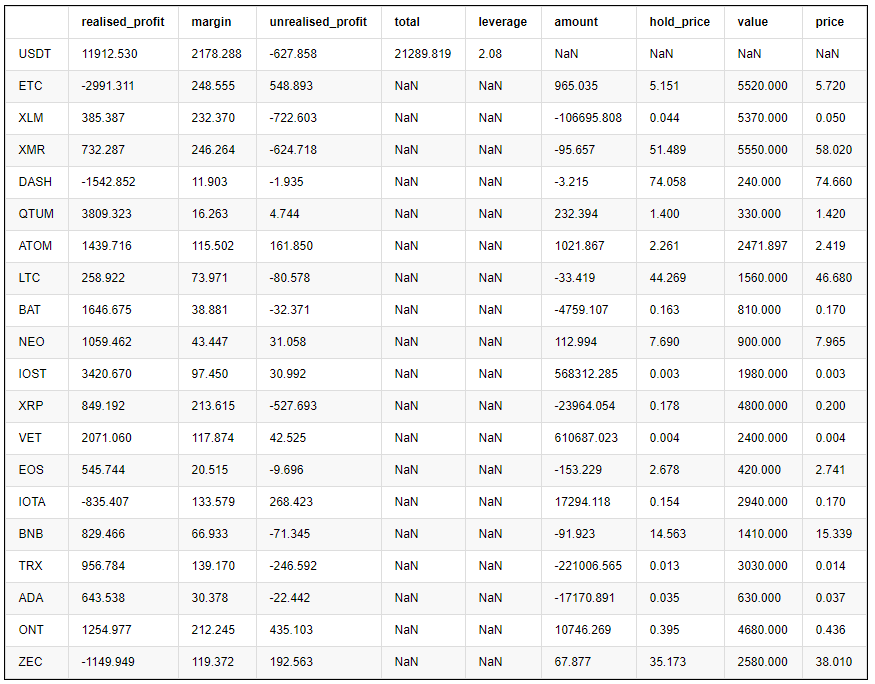
Why improve
The original biggest problem is the comparison between the latest price and the initial price started by the strategy. As the time passes, it will become more and more deviated. We will accumulate a lot of positions in these currencies. The biggest problem with filtering currencies is that we may still have unique currencies in the future based on our past experience. The following is the performance of non-filtering mode. In fact, when trade_value = 300, in the middle stage of the strategy running, it has already lost everything. Even if it is not, LINK and XTZ also hold positions above 10000USDT, which is too large. Therefore, we must solve this problem in the backtest and pass the test of all currencies.
trade_symbols = list(set(symbols)) # Remaining currencies
price_usdt_btc_norm_mean = price_usdt_btc_norm[trade_symbols].mean(axis=1)
e = Exchange(trade_symbols,initial_balance=10000,commission=0.0005,log=False)
trade_value = 300
for row in price_usdt.iloc[:].iterrows():
e.Update(row[0], row[1])
empty_value = 0
for symbol in trade_symbols:
price = row[1][symbol]
if np.isnan(price):
continue
diff = price_usdt_btc_norm.loc[row[0],symbol] - price_usdt_btc_norm_mean[row[0]]
aim_value = -trade_value*round(diff/0.01,1)
now_value = e.account[symbol]['value']*np.sign(e.account[symbol]['amount'])
empty_value += now_value
if aim_value - now_value > 20:
e.Buy(symbol, price, round((aim_value - now_value)/price, 6),round(e.account[symbol]['realised_profit']+e.account[symbol]['unrealised_profit'],2))
if aim_value - now_value < -20:
e.Sell(symbol, price, -round((aim_value - now_value)/price, 6),round(e.account[symbol]['realised_profit']+e.account[symbol]['unrealised_profit'],2))
stragey_2c = e
(stragey_2c.df['total']/stragey_2c.initial_balance).plot(figsize=(17,6),grid = True);
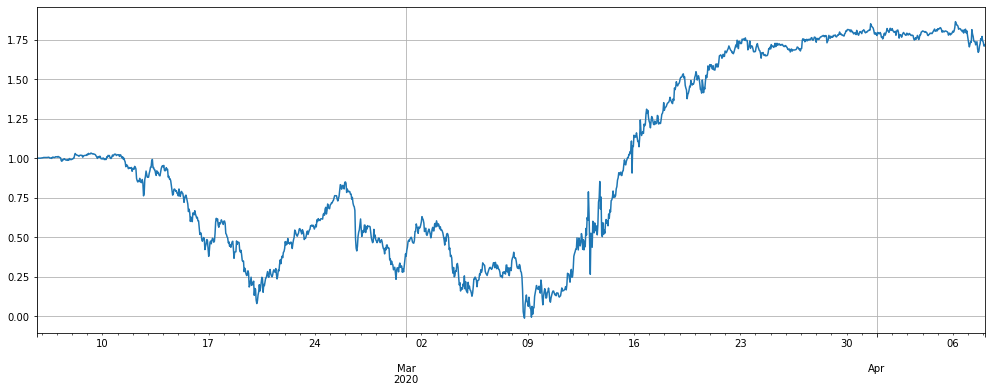
pd.DataFrame(stragey_2c.account).T.apply(lambda x:round(x,3)) # Last holding position

((price_usdt_btc_norm.iloc[-1:] - price_usdt_btc_norm_mean[-1]).T) # Each currency deviates from the initial situation

Since the cause of the problem is to compare with the initial price, it may be more and more biased. We can compare it with the moving average of the past period of time, backtest the full currency and see the results below.
Alpha = 0.05
#price_usdt_btc_norm2 = price_usdt_btc/price_usdt_btc.rolling(20).mean() #Ordinary moving average
price_usdt_btc_norm2 = price_usdt_btc/price_usdt_btc.ewm(alpha=Alpha).mean() # Here is consistent with the strategy, using EMA
trade_symbols = list(set(symbols))#All currencies
price_usdt_btc_norm_mean = price_usdt_btc_norm2[trade_symbols].mean(axis=1)
e = Exchange(trade_symbols,initial_balance=10000,commission=0.0005,log=False)
trade_value = 300
for row in price_usdt.iloc[:].iterrows():
e.Update(row[0], row[1])
empty_value = 0
for symbol in trade_symbols:
price = row[1][symbol]
if np.isnan(price):
continue
diff = price_usdt_btc_norm2.loc[row[0],symbol] - price_usdt_btc_norm_mean[row[0]]
aim_value = -trade_value*round(diff/0.01,1)
now_value = e.account[symbol]['value']*np.sign(e.account[symbol]['amount'])
empty_value += now_value
if aim_value - now_value > 20:
e.Buy(symbol, price, round((aim_value - now_value)/price, 6),round(e.account[symbol]['realised_profit']+e.account[symbol]['unrealised_profit'],2))
if aim_value - now_value < -20:
e.Sell(symbol, price, -round((aim_value - now_value)/price, 6),round(e.account[symbol]['realised_profit']+e.account[symbol]['unrealised_profit'],2))
stragey_2d = e
#print(N,stragey_2d.df['total'][-1],pd.DataFrame(stragey_2d.account).T.apply(lambda x:round(x,3))['value'].sum())
The performance of the strategy has fully met our expectations, and the returns are almost the same. The situation of bursting account positions in the original currency of the entire currencies has also smoothly transitioned, and there is almost no retracement. The same opening position size, almost all leverage is below 1 times, on 12th March 2020 price plunged extreme case, it still does not exceed 4 times, which means that we can increase trade_value, and under the same leverage, double the profit. The final holding position is only BCH exceeding 1000USDT, which is very good.
Why would the position be lowered? Imagine joining the altcoin index unchanged, one coin has increased by 100%, and it will be maintained for a long time. The original strategy will hold short positions of 300 * 100 = 30000USDT for a long time, and the new strategy will eventually track the benchmark price At the latest price, you will not hold any position at the end.
(stragey_2d.df['total']/stragey_2d.initial_balance).plot(figsize=(17,6),grid = True);
#(stragey_2c.df['total']/stragey_2c.initial_balance).plot(figsize=(17,6),grid = True);
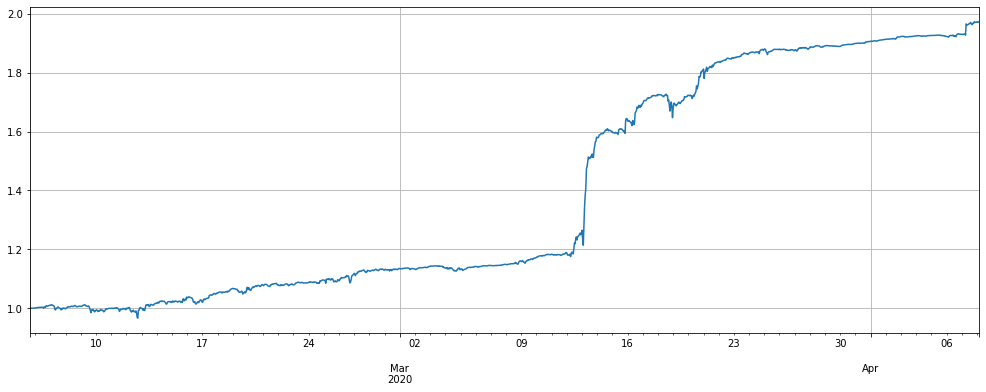
stragey_2d.df['leverage'].plot(figsize=(18,6),grid = True);
stragey_2b.df['leverage'].plot(figsize=(18,6),grid = True); # Screen currency strategy leverage
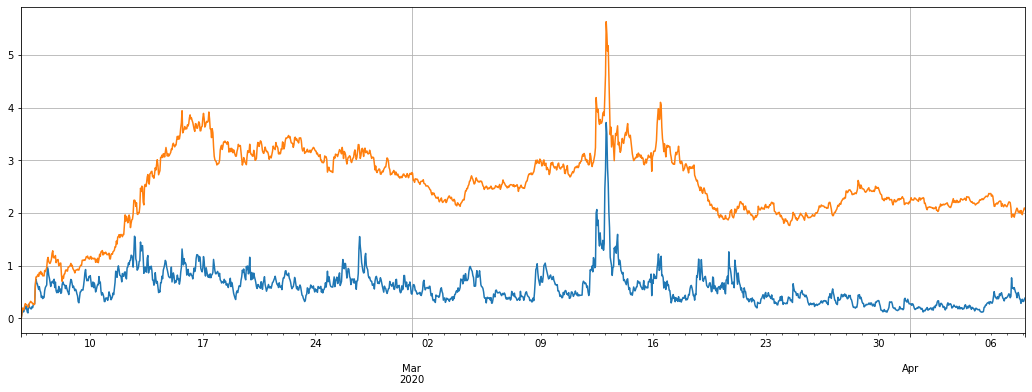
pd.DataFrame(stragey_2d.account).T.apply(lambda x:round(x,3))
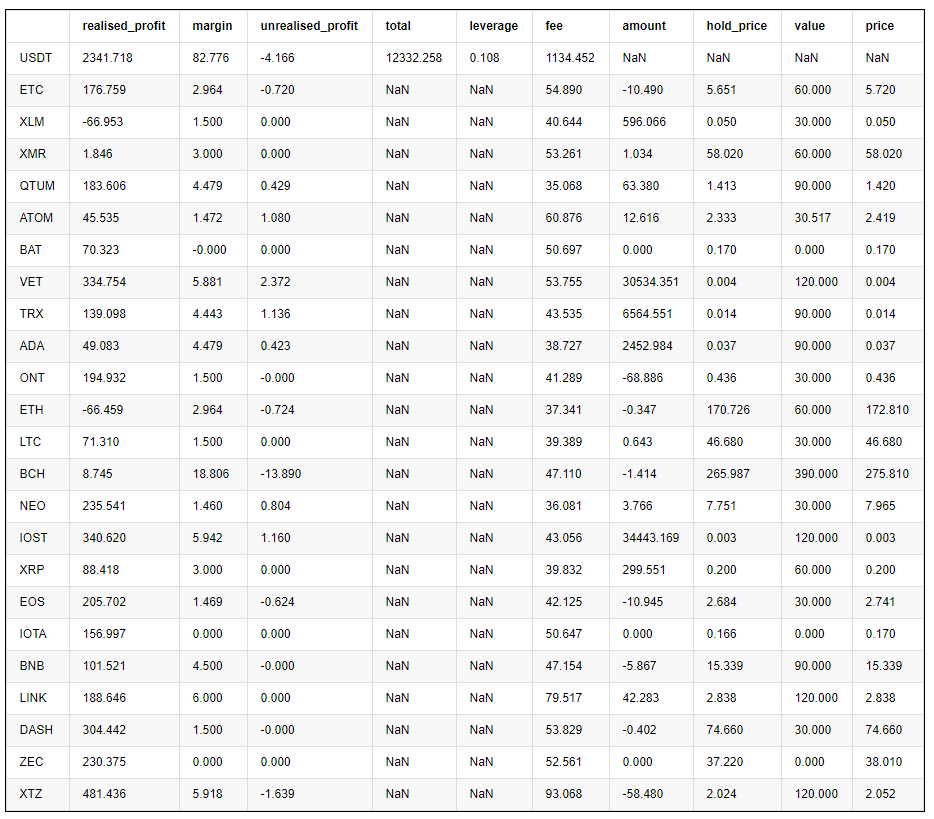
What will happen to the currency with the screening mechanism, with the same parameters, the earlier stage profits performs better, the retracement is smaller, but the overall returns are slightly lower. Therefore, it is recommended to have a screening mechanism.
#price_usdt_btc_norm2 = price_usdt_btc/price_usdt_btc.rolling(50).mean()
price_usdt_btc_norm2 = price_usdt_btc/price_usdt_btc.ewm(alpha=0.05).mean()
trade_symbols = list(set(symbols)-set(['LINK','XTZ','BCH', 'ETH'])) # Remaining currencies
price_usdt_btc_norm_mean = price_usdt_btc_norm2[trade_symbols].mean(axis=1)
e = Exchange(trade_symbols,initial_balance=10000,commission=0.0005,log=False)
trade_value = 300
for row in price_usdt.iloc[:].iterrows():
e.Update(row[0], row[1])
empty_value = 0
for symbol in trade_symbols:
price = row[1][symbol]
if np.isnan(price):
continue
diff = price_usdt_btc_norm2.loc[row[0],symbol] - price_usdt_btc_norm_mean[row[0]]
aim_value = -trade_value*round(diff/0.01,1)
now_value = e.account[symbol]['value']*np.sign(e.account[symbol]['amount'])
empty_value += now_value
if aim_value - now_value > 20:
e.Buy(symbol, price, round((aim_value - now_value)/price, 6),round(e.account[symbol]['realised_profit']+e.account[symbol]['unrealised_profit'],2))
if aim_value - now_value < -20:
e.Sell(symbol, price, -round((aim_value - now_value)/price, 6),round(e.account[symbol]['realised_profit']+e.account[symbol]['unrealised_profit'],2))
stragey_2e = e
#(stragey_2d.df['total']/stragey_2d.initial_balance).plot(figsize=(17,6),grid = True);
(stragey_2e.df['total']/stragey_2e.initial_balance).plot(figsize=(17,6),grid = True);
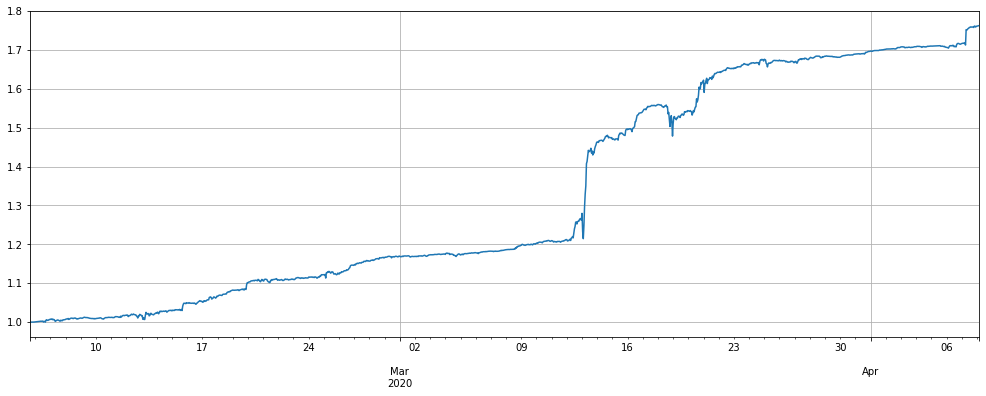
stragey_2e.df['leverage'].plot(figsize=(18,6),grid = True);
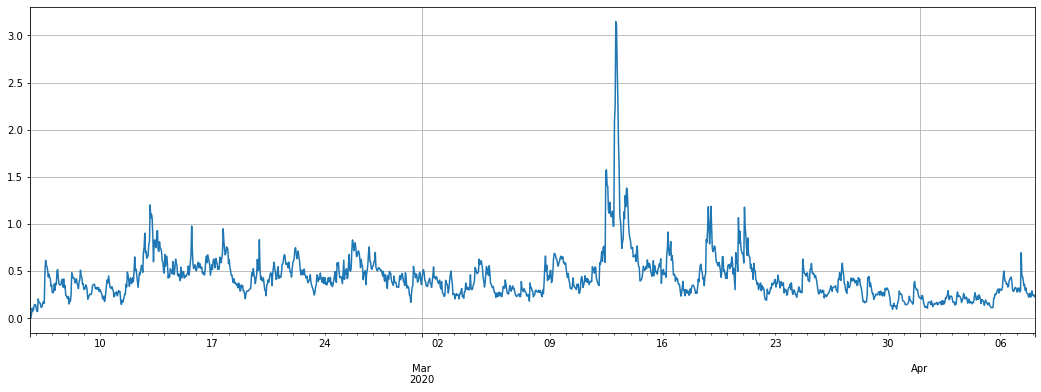
pd.DataFrame(stragey_2e.account).T.apply(lambda x:round(x,3))
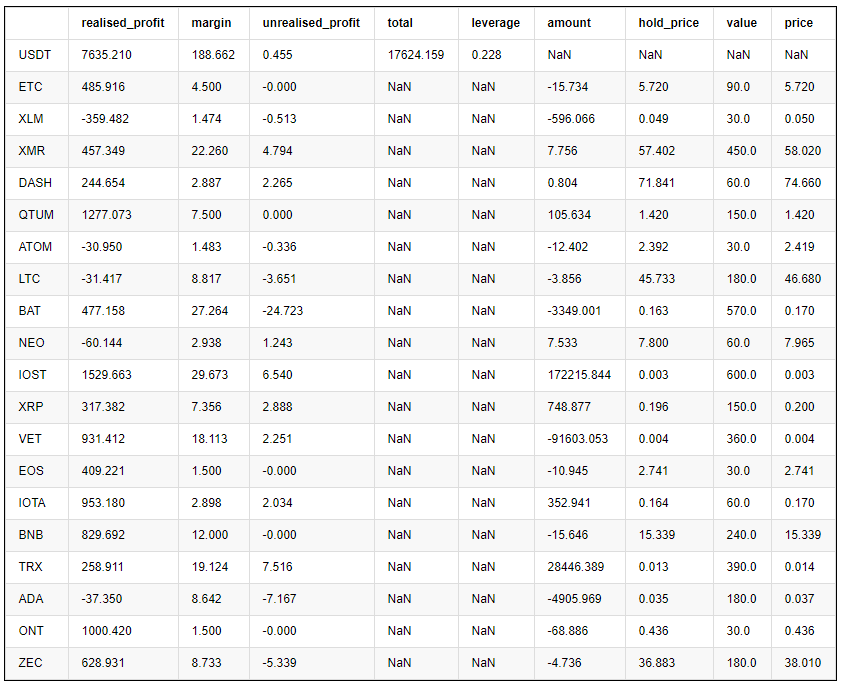
Parameter optimization
The larger the setting of the Alpha parameter of the exponential moving average, the more sensitive the benchmark price tracking, the less transactions, the lower the final holding position. when lower the leverage, the return also reduced. Lower the maximum retracement, it can increase transaction volume. The specific balance operations need based on the backtest results.
Since the backtest is a 1h K line, it can only be updated once an hour, the real market can be updated faster, and it is necessary to weigh the specific settings comprehensively.
This is the result of optimization:
for Alpha in [i/100 for i in range(1,30)]:
#price_usdt_btc_norm2 = price_usdt_btc/price_usdt_btc.rolling(20).mean() # Ordinary moving average
price_usdt_btc_norm2 = price_usdt_btc/price_usdt_btc.ewm(alpha=Alpha).mean() # Here is consistent with the strategy, using EMA
trade_symbols = list(set(symbols))# All currencies
price_usdt_btc_norm_mean = price_usdt_btc_norm2[trade_symbols].mean(axis=1)
e = Exchange(trade_symbols,initial_balance=10000,commission=0.0005,log=False)
trade_value = 300
for row in price_usdt.iloc[:].iterrows():
e.Update(row[0], row[1])
empty_value = 0
for symbol in trade_symbols:
price = row[1][symbol]
if np.isnan(price):
continue
diff = price_usdt_btc_norm2.loc[row[0],symbol] - price_usdt_btc_norm_mean[row[0]]
aim_value = -trade_value*round(diff/0.01,1)
now_value = e.account[symbol]['value']*np.sign(e.account[symbol]['amount'])
empty_value += now_value
if aim_value - now_value > 20:
e.Buy(symbol, price, round((aim_value - now_value)/price, 6),round(e.account[symbol]['realised_profit']+e.account[symbol]['unrealised_profit'],2))
if aim_value - now_value < -20:
e.Sell(symbol, price, -round((aim_value - now_value)/price, 6),round(e.account[symbol]['realised_profit']+e.account[symbol]['unrealised_profit'],2))
stragey_2d = e
# These are the final net value, the initial maximum backtest, the final position size, and the handling fee
print(Alpha, round(stragey_2d.account['USDT']['total'],1), round(1-stragey_2d.df['total'].min()/stragey_2d.initial_balance,2),round(pd.DataFrame(stragey_2d.account).T['value'].sum(),1),round(stragey_2d.account['USDT']['fee']))
0.01 21116.2 0.14 15480.0 2178.0
0.02 20555.6 0.07 12420.0 2184.0
0.03 20279.4 0.06 9990.0 2176.0
0.04 20021.5 0.04 8580.0 2168.0
0.05 19719.1 0.03 7740.0 2157.0
0.06 19616.6 0.03 7050.0 2145.0
0.07 19344.0 0.02 6450.0 2133.0
0.08 19174.0 0.02 6120.0 2117.0
0.09 18988.4 0.01 5670.0 2104.0
0.1 18734.8 0.01 5520.0 2090.0
0.11 18532.7 0.01 5310.0 2078.0
0.12 18354.2 0.01 5130.0 2061.0
0.13 18171.7 0.01 4830.0 2047.0
0.14 17960.4 0.01 4770.0 2032.0
0.15 17779.8 0.01 4531.3 2017.0
0.16 17570.1 0.01 4441.3 2003.0
0.17 17370.2 0.01 4410.0 1985.0
0.18 17203.7 0.0 4320.0 1971.0
0.19 17016.9 0.0 4290.0 1955.0
0.2 16810.6 0.0 4230.6 1937.0
0.21 16664.1 0.0 4051.3 1921.0
0.22 16488.2 0.0 3930.6 1902.0
0.23 16378.9 0.0 3900.6 1887.0
0.24 16190.8 0.0 3840.0 1873.0
0.25 15993.0 0.0 3781.3 1855.0
0.26 15828.5 0.0 3661.3 1835.0
0.27 15673.0 0.0 3571.3 1816.0
0.28 15559.5 0.0 3511.3 1800.0
0.29 15416.4 0.0 3481.3 1780.0
- Python Version Commodity Futures Moving Average Strategy
- Market quotes collector upgrade again
- 行情收集器再升级--支持CSV格式文件导入提供自定义数据源
- Commodity Futures High Frequency Trading Strategy written by C++
- Larry Connors RSI2 Mean Reversion Strategy
- 奥克手把手教你用JS对接FMZ扩展API
- Based on the use of a new relative strength index in intraday strategies
- Research on Binance Futures Multi-currency Hedging Strategy Part 4
- Larry Connors拉里·康纳斯 RSI2均值回归策略
- Research on Binance Futures Multi-currency Hedging Strategy Part 3
- Research on Binance Futures Multi-currency Hedging Strategy Part 1
- 手把手教你给行情收集器升级回测自定义数据源功能
- Crocodile line trading system Python version
- 使用发明者量化交易平台扩展API实现TradingView报警信号交易(推荐)
- JavaScript version SuperTrend strategy
- SuperTrend V.1--超级趋势线系统
- JavaScript版本SuperTrend策略
- [千团大战]币安期货多币种对冲策略最近的复盘和分钟级K线回测的结果(第4篇)
- 手把手教你实现一个行情收集器
- [千团大战]币安期货做空超涨做多超跌策略风险分析(第3篇)